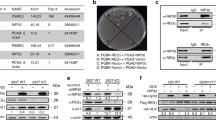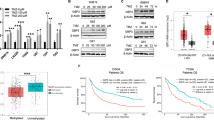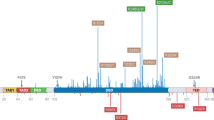Abstract
A critical challenge in cancer research is to identify genetic lesions that sensitize patients to chemotherapy. p53, which is mutated in nearly one-third to half of glioblastomas, may be such a lesion. In this paper, we demonstrate that p53 disruption dramatically sensitizes glioblastoma cells to DNA topoisomerase I inhibitor-mediated apoptosis. Using 19 glioblastoma cell lines, including 15 low-passage ex vivo cell lines derived from patients, as well as isogenic glioblastoma cells varying in p53 status, we show that clinically relevant levels of SN-38 potently induce cell cycle arrest and temporary senescence in glioblastoma cells with wild-type p53 while causing massive apoptosis in p53-deficient cells (P<0.0002). We demonstrate that glioblastoma cells with wild-type p53 proliferate when recultured in drug-free medium, whereas p53-deficient cells do not. We also show that p16 protein expression is neither necessary nor sufficient for initiation and/or maintenance of SN-38-induced arrest/senescence. These results indicate that p53 disruption has a dramatic effect on how glioblastoma cells process topoisomerase I inhibitor-mediated DNA damage.
This is a preview of subscription content, access via your institution
Access options
Subscribe to this journal
Receive 50 print issues and online access
$259.00 per year
only $5.18 per issue
Buy this article
- Purchase on Springer Link
- Instant access to full article PDF
Prices may be subject to local taxes which are calculated during checkout






Similar content being viewed by others
References
Agami R, Blandino G, Oren M and Shaul Y . (1999). Nature, 399, 809–813.
Ahrendt SA, Halachmi S, Chow JT, Wu L, Halachmi N, Yang SC, Wehage S, Jen J and Sidransky D . (1999). Proc. Natl. Acad. Sci. USA, 96, 7382–7387.
Amundson SA, Myers TG and Fornace Jr AJ . (1998). Oncogene, 17, 3287–3299.
Azzam EI, de Toledo SM, Pykett MJ, Nagasawa H and Little JB . (1997). Cell Growth Differ., 8, 1161–1169.
Bachoo RM, Maher EA, Ligon KL, Sharpless NE, Chan SS, You MJ, Tang Y, DeFrances J, Stover E, Weissleder R, Rowitch DH, Louis DN and DePinho RA . (2002). Cancer Cell, 1, 269–277.
Brown JM and Wouters BG . (1999). Cancer Res., 59, 1391–1399.
Chang BD, Broude EV, Dokmanovic M, Zhu H, Ruth A, Xuan Y, Kandel ES, Lausch E, Christov K and Roninson IB . (1999). Cancer Res., 59, 3761–3767.
Choe G, Horvath S, Cloughesy TF, Crosby K, Seligson D, Palotie A, Inge L, Smith BL, Sawyers CL and Mischel PS . (2003). Cancer Res., 63, 2742–2746.
Choe G, Park JK, Jouben-Steele L, Kremen TJ, Liau LM, Vinters HV, Cloughesy TF and Mischel PS . (2002). Clin. Cancer Res., 8, 2894–2901.
Coggins CA, Elion GB, Houghton PJ, Hare CB, Keir S, Colvin OM, Bigner DD and Friedman HS . (1998). Cancer Chemother. Pharmacol., 41, 485–490.
Dimri GP, Lee X, Basile G, Acosta M, Scott G, Roskelley C, Medrano EE, Linskens M, Rubelj I and Pereira-Smith O . (1995). Proc. Natl. Acad. Sci. USA, 92, 9363–9367.
Druker BJ . (2002). Cancer Cell, 1, 31–36.
Flatt PM, Tang LJ, Scatena CD, Szak ST and Pietenpol JA . (2000). Mol. Cell. Biol., 20, 4210–4223.
Friedman HS, Petros WP, Friedman AH, Schaaf LJ, Kerby T, Lawyer J, Parry M, Houghton PJ, Lovell S, Rasheed K, Cloughsey T, Stewart ES, Colvin OM, Provenzale JM, McLendon RE, Bigner DD, Cokgor I, Haglund M, Rich J, Ashley D, Malczyn J, Elfring GL and Miller LL . (1999). J. Clin. Oncol., 17, 1516–1525.
Giani C and Finocchiaro G . (1994). Cancer Res., 54, 6338–6339.
Gong JG, Costanzo A, Yang HQ, Melino G, Kaelin Jr WG, Levrero M and Wang JY . (1999). Nature, 399, 806–809.
Han Z, Wei W, Dunaway S, Darnowski JW, Calabresi P, Sedivy J, Hendrickson EA, Balan KV, Pantazis P and Wyche JH . (2002). J. Biol. Chem., 277, 17154–17160.
Hare CB, Elion GB, Houghton PJ, Houghton JA, Keir S, Marcelli SL, Bigner DD and Friedman HS . (1997). Cancer Chemother. Pharmacol., 39, 187–191.
Ino Y, Betensky RA, Zlatescu MC, Sasaki H, Macdonald DR, Stemmer-Rachamimov AO, Ramsay DA, Cairncross JG and Louis DN . (2001). Clin. Cancer Res., 7, 839–845.
Jen J, Harper JW, Bigner SH, Bigner DD, Papadopoulos N, Markowitz S, Willson JK, Kinzler KW and Vogelstein B . (1994). Cancer Res., 54, 6353–6358.
Keshelava N, Zuo JJ, Chen P, Waidyaratne SN, Luna MC, Gomer CJ, Triche TJ and Reynolds CP . (2001). Cancer Res., 61, 6185–6193.
Kleihues P, Louis DN, Scheithauer BW, Rorke LB, Reifenberger G, Burger PC and Cavenee WK . (2002). J. Neuropathol. Exp. Neurol., 61, 215–225.
Kleihues P and Ohgaki H . (1999). Neuro-oncol., 1, 44–51.
Larsen JK . (1994). Methods Cell Biol., 41, 377–388.
Liu LF, Desai SD, Li TK, Mao Y, Sun M and Sim SP . (2000). Ann. NY Acad. Sci., 922, 1–10.
Liu ZG, Baskaran R, Lea-Chou ET, Wood LD, Chen Y, Karin M and Wang JY . (1996). Nature, 384, 273–276.
Magrini R, Bhonde MR, Hanski ML, Notter M, Scherubl H, Boland CR, Zeitz M and Hanski C . (2002). Int. J. Cancer, 101, 23–31.
Merlo A, Herman JG, Mao L, Lee DJ, Gabrielson E, Burger PC, Baylin SB and Sidransky D . (1995). Nat. Med., 1, 686–692.
Mischel PS and Cloughesy TF . (2003). Brain Pathol., 13, 52–61.
Mischel PS, Shai R, Shi T, Horvath S, Lu KV, Choe G, Seligson D, Kremen TJ, Palotie A, Liau LM, Cloughesy TF and Nelson SF . (2003). Oncogene, 22, 2361–2373.
Negoro S, Fukuoka M, Masuda N, Takada M, Kusunoki Y, Matsui K, Takifuji N, Kudoh S, Niitani H and Taguchi T . (1991). J. Natl. Cancer Inst., 83, 1164–1168.
Nieves-Neira W and Pommier Y . (1999). Int. J. Cancer, 82, 396–404.
Roninson IB . (2003). Cancer Res., 63, 2705–2715.
Sawyers CL . (2002). Curr. Opin. Genet. Dev., 12, 111–115.
Scheffner M, Huibregtse JM, Vierstra RD and Howley PM . (1993). Cell, 75, 495–505.
Shai R, Shi T, Kremen TJ, Horvath S, Liau LM, Cloughesy TF, Mischel PS and Nelson SF . (2003). Gene expression profiling identifies molecular subtypes of gliomas. Oncogene, 22, 4918–4923.
Shao RG, Cao CX, Nieves-Neira W, Dimanche-Boitrel MT, Solary E and Pommier Y . (2001). Oncogene, 20, 1852–1859.
Shawver LK, Slamon D and Ullrich A . (2002). Cancer Cell, 1, 117–123.
Slichenmyer WJ, Nelson WG, Slebos RJ and Kastan MB . (1993). Cancer Res., 53, 4164–4168.
te Poele RH, Okorokov AL, Jardine L, Cummings J and Joel SP . (2002). Cancer Res., 62, 1876–1883.
Truong T, Sun G, Doorly M, Wang JY and Schwartz MA . (2003). Proc. Natl. Acad Sci. USA, 100, 10281–10286.
Vivo C, Liu W and Broaddus VC . (2003). J. Biol. Chem., 278, 25461–25467.
Vousden KH . (2000). Cell, 103, 691–694.
Watanabe K, Tachibana O, Sata K, Yonekawa Y, Kleihues P and Ohgaki H . (1996). Brain Pathol., 6, 217–223.
Weller M, Rieger J, Grimmel C, Van Meir EG, De Tribolet N, Krajewski S, Reed JC, von Deimling A and Dichgans J . (1998). Int. J. Cancer, 79, 640–644.
Yang J and Duerksen-Hughes PJ . (2001). J. Biol. Chem., 276, 27129–27135.
Yuan ZM, Shioya H, Ishiko T, Sun X, Gu J, Huang YY, Lu H, Kharbanda S, Weichselbaum R and Kufe D . (1999). Nature, 399, 814–817.
Zeng M, Kumar A, Meng G, Gao Q, Dimri G, Wazer D, Band H and Band V . (2002). J. Biol. Chem., 277, 45611–45618.
Acknowledgements
We are grateful to Drs William McBride, Adrienne Scheck, Stanley Nelson, Harvey Herschman and Jonathan Braun for their helpful comments on this manuscript. We thank Dr C Patrick Reynolds for providing packaging cell lines PA317-pLXSN and PA317-pLXSN16E6. This work was supported by K08NS43147-01 from the National Institute of Neurological Disorders and Stroke (PSM) and U01 CA88127 from the National Cancer Institute (PSM is a co-PI). This work was also supported by an Accelerate Brain Cancer Cure Award, a Henry E Singleton Brain Tumor Fellowship, a generous donation from the Kevin Riley family to UCLA Comprehensive Brain Tumor Program, and the Harry Allgauer Foundation through The Doris R Ullmann Fund for Brain Tumor Research Technologies. Yinglin Wang is a postdoctoral trainee supported by Institutional National Research Service Award T32-NS07449, a Translational Research Grant from American Brain Tumor Association, and a fellowship from UCLA Jonsson Cancer Center Foundation.
Author information
Authors and Affiliations
Corresponding author
Rights and permissions
About this article
Cite this article
Wang, Y., Zhu, S., Cloughesy, T. et al. p53 disruption profoundly alters the response of human glioblastoma cells to DNA topoisomerase I inhibition. Oncogene 23, 1283–1290 (2004). https://doi.org/10.1038/sj.onc.1207244
Received:
Revised:
Accepted:
Published:
Issue Date:
DOI: https://doi.org/10.1038/sj.onc.1207244
Keywords
This article is cited by
-
WNT signaling modulates chemoresistance to temozolomide in p53-mutant glioblastoma multiforme
Apoptosis (2022)
-
A way to understand idiopathic senescence and apoptosis in primary glioblastoma cells – possible approaches to circumvent these phenomena
BMC Cancer (2019)
-
Induction of senescence in primary glioblastoma cells by serum and TGFβ
Scientific Reports (2017)
-
Clinically applicable human adipose tissue-derived mesenchymal stem cells delivering therapeutic genes to brainstem gliomas
Cancer Gene Therapy (2015)
-
Cytostasis and morphological changes induced by mifepristone in human metastatic cancer cells involve cytoskeletal filamentous actin reorganization and impairment of cell adhesion dynamics
BMC Cancer (2013)



